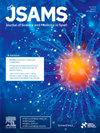Anaerobic speed reserve and acute responses to a short-format high-intensity interval session in runners
IF 3.4
2区 医学
Q1 SPORT SCIENCES
引用次数: 0
Abstract
Objectives
This study aimed to assess relationships of acute responses to short-format high-intensity interval training (HIIT) with the anaerobic speed reserve (ASR) of adolescent runners.
Design
Pre-post intervention design.
Methods
Eighteen highly-trained youth runners (15.83 ± 0.86 years) underwent maximal sprinting speed (MSS) and maximal aerobic speed (MAS) assessments to determine ASR (MSS minus MAS) and a standardized HIIT protocol (2 × (20 × 15 s/15 s @110 % MAS)) was administered. Pre/post-HIIT assessments included biochemical (i.e., creatine kinase (CK)), neuromuscular (countermovement jump, CMJ; reactive strength index, RSI), cardiac (i.e., heart rate recovery (HRR)), and athlete-reported outcome measures (e.g., single item for fatigue). Pearson's r was calculated to assess relationships between acute responses and ASR, MSS, MAS, and relative intensity of the HIIT (%ASR).
Results
Athletes' ASR and %ASR were significantly associated with the pre/post difference of CK (r = − 0.75; p < 0.001; r = 0.74; p < 0.001, respectively), CMJ height, and RSI (r ≥ 0.69; p ≤ 0.002; r ≤ − 0.49; p ≤ 0.04, respectively). However, HRR did not correlate significantly with ASR or %ASR (r ≤ 0.37, p ≥ 0.131, r ≥ − 0.31; p ≥ 0.22, respectively). The pre/post difference of RSI correlated with MAS (r = − 0.54; p = 0.02), and the pre/post difference of CK (r = − 0.50; p = 0.034) and of CMJ height (r = 0.76; p < 0.001) with MSS. Regarding athlete-reported measures, ASR and %ASR showed significant associations with most fatigue and recovery variables (r ≥ 0.57; p ≤ 0.014, r ≥ 0.57; p ≤ 0.013, respectively). The pre/post difference of the single item for fatigue showed a positive relationship with MSS (r = 0.49; p = 0.037).
Conclusions
Acute biochemical, neuromuscular, and athlete-reported responses to short-format HIIT showed strong relationships with ASR and MSS, indicating higher internal load in athletes with a lower ASR and MSS by using a higher %ASR, compared to athletes with a higher ASR and MSS. These findings can help to tailor training programs to individual needs and avoid possible overload.
无氧速度储备和跑步者短时高强度间歇训练的急性反应。
目的:本研究旨在评估青少年跑步者短时间高强度间歇训练(HIIT)的急性反应与无氧速度储备(ASR)的关系。设计:干预前后设计。方法:18训练有素的青年运动员(15.83 ±0.86 年)经历了最大短跑速度(MSS)和最大有氧速度(MAS)评估来确定ASR (MSS - MAS)和一个标准化的这种训练协议(2 × (20 × 15 / 15 年代@110 % MAS))是管理。hiit前/后评估包括生化(即肌酸激酶(CK))、神经肌肉(反运动跳跃,CMJ;反应性强度指数(RSI),心脏(即心率恢复(HRR))和运动员报告的结果测量(例如,疲劳单项)。计算Pearson’s r来评估急性反应与ASR、MSS、MAS和HIIT相对强度(%ASR)之间的关系。结果:运动员ASR和%ASR与CK前后差异显著相关(r = -0.75;p 结论:短期HIIT的急性生化、神经肌肉和运动员报告的反应与ASR和MSS有很强的关系,表明与ASR和MSS较高的运动员相比,ASR和MSS较低的运动员使用较高的ASR和MSS。这些发现有助于根据个人需要定制培训计划,避免可能的超负荷。
本文章由计算机程序翻译,如有差异,请以英文原文为准。
求助全文
约1分钟内获得全文
求助全文
来源期刊
CiteScore
7.40
自引率
10.00%
发文量
198
审稿时长
48 days
期刊介绍:
The Journal of Science and Medicine in Sport is the official journal of Sports Medicine Australia (SMA) and is an an international refereed research publication covering all aspects of sport science and medicine.
The Journal considers for publication Original research and Review papers in the sub-disciplines relating generally to the broad sports medicine and sports science fields: sports medicine, sports injury (including injury epidemiology and injury prevention), physiotherapy, podiatry, physical activity and health, sports science, biomechanics, exercise physiology, motor control and learning, sport and exercise psychology, sports nutrition, public health (as relevant to sport and exercise), and rehabilitation and injury management. Manuscripts with an interdisciplinary perspective with specific applications to sport and exercise and its interaction with health will also be considered.

 求助内容:
求助内容: 应助结果提醒方式:
应助结果提醒方式:


